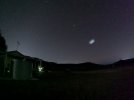ttguy
New Member
This Article in Canberra weekly features this image by a photographer named Ari Rex.
The article says "On Friday 14 July at about 8pm, during a photoshoot far away from city light pollution near Gundaroo, Ari and five clients witnessed – and documented – an object in the night sky that he couldn’t explain. A possible explanation is that India’s space agency launched a rocket into orbit around the same time. "
If this is not some hoax to drive interest to this guy's astrophotography business then I reckon the metabunkiens here could have a shot at IDing this. Since we have, time location and stars.
Ideas?
The article says "On Friday 14 July at about 8pm, during a photoshoot far away from city light pollution near Gundaroo, Ari and five clients witnessed – and documented – an object in the night sky that he couldn’t explain. A possible explanation is that India’s space agency launched a rocket into orbit around the same time. "
If this is not some hoax to drive interest to this guy's astrophotography business then I reckon the metabunkiens here could have a shot at IDing this. Since we have, time location and stars.
Ideas?
Last edited:






